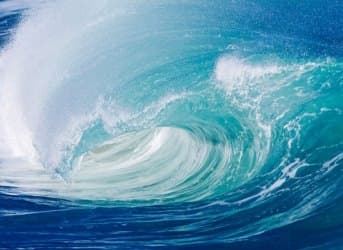Summer is coming in the Northern Hemisphere and tens of millions of us have plans to flock to the beaches. As we frolic along the shore we will also be awed by the relentless, eternal power of the ocean.
This power has been tantalizing engineers since the dawn of the electric age in the 19th century. Those great tidal havens, the Bay of Fundy and the Bay of Biscay, have had electrical entrepreneurs salivating down through the years.
Yet harnessing the ultimate renewable energy resource has lagged its two big renewable competitors, wind and solar. Both are now mature alternative energy-generating sources, picking up an increasing part of the electricity market without producing any greenhouse gasses.
Sean O’Neill, executive director of the Foundation for Ocean Renewables, says ocean energy technology has so far not been ready for large deployment, but it soon will be.
In the United States, there are complex legal hurdles from activists, who worry that beaches could be impaired and their recreational value diminished, and then there’s the fascinating challenge of determining who in government is responsible for licensing this new use of the ocean. Contenders include the Department of the Interior, the Navy, the Coast Guard, the Army Corps of Engineers and the Federal Energy Regulatory Commission, which controls the electric markets.
What about fishing? The states will want a say with their coastal commissions. What about offshore shipping lanes and even recreational boating? The oceans are vast and already invaded by drilling rigs, wind turbines and undersea military activity, to say nothing of traditional marine uses like shipping, fishing and boating.
Yet, so far, the problems have been technological rather than governmental. The sea is a great resource, but it is a hostile environment for mechanical and electrical equipment. At present, the nascent ocean energy industry is still sorting through a galaxy of devices for making electricity from ocean kinetic power. These show engineering imagination run riot -- gloriously so.
Related Article: Buffett Says He Will Double Investment In Renewables
As many as 100 machines for harnessing the ocean are being developed around the world. They can be described as gizmos, widgets, gadgets, devices, or dream machines.
Machine design for ocean kinetic power is at the stage that flight was in the 1920s, and the devices are spectacular in a Rube Goldberg kind of way, at least to the eye of a non-engineer. There are big hinges, designed to flap in the waves, and buoys that pop up and down with the waves, generating electricity through a mechanism like you find in a self-winding wristwatch. Just as a person jiggles a wristwatch and it winds, so too the waves jiggle the buoy and it turns a turbine, which makes electricity.
There are wildly diverse approaches including one, called an oscillating water column, that uses compressed air from wave action to turn a turbine. Another set of machines is destined to work on tides and can consist of helical turbines, which look like gigantic eggbeaters, or machines that look like wind turbines, but they are sunk in the tidal path or on strongly running rivers. The latter are being tested in New York City’s East River. Anadarko, an oil company, wants to put turbines miles deep in the Gulf Stream.
ADVERTISEMENT
Ireland and Scotland – the latter the world leader in the ocean power race – are generating electricity from the ocean on a small scale. At East Port and Lubec in Maine and Yakutat in Alaska, small plants are being installed.
As solar power was first used in remote locations, the immediate appeal for ocean power is for remote locations, too. Settlements and villages in Alaska have the costliest electricity in the country.
The Foundation for Ocean Renewables’ O’Neill estimates that tidal will be the salvation of many of Alaska’s remote villages; unlike wind and solar, it would be there 24/7 -- in the dead of winter as well as in high summer.
By Llewellyn King


















